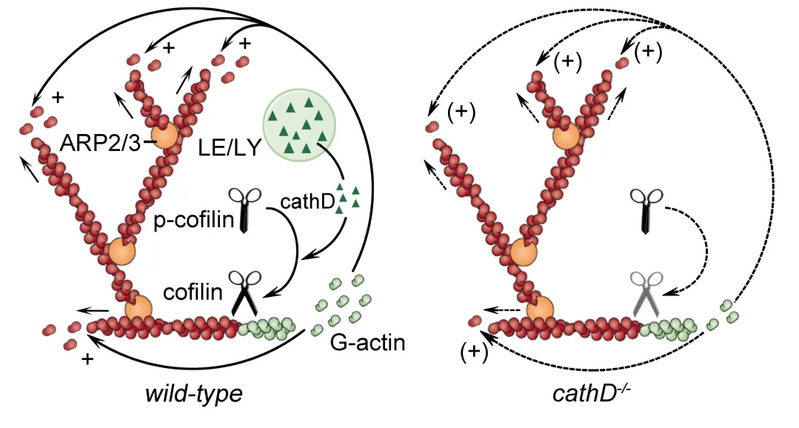The research team led by Prof. DUAN Shumin has recently published an article titled Late endosomes promote microglia migration via cytosolic translocation of immature protease cathD in Science Advances on Dec 9th. This research uncovered a novel role of endosomal/lysosomal vesicles in regulating actin-cytoskeleton dynamics during ATP signaling-evoked microglia migration.
Organelle transport requires dynamic cytoskeleton remodeling, but whether cytoskeletal dynamics are, in turn, regulated by organelles remains elusive. This work demonstrates that late endosomes, a type of prelysosomal organelles, facilitate actin-cytoskeleton remodeling via cytosolic translocation of immature protease cathepsin D (cathD) during microglia migration. After cytosolic translocation, late endosome–derived cathD juxtaposes actin filaments at the leading edge of lamellipodia. Suppressing cathD expression or blocking its cytosolic translocation impairs the maintenance but not the initiation of lamellipodial extension. Moreover, immature cathD balances the activity of the actin-severing protein cofilin to maintain globular-actin (G-actin) monomer pool for local actin recycling. This research identifies cathD as a key lysosomal molecule that unconventionally contribute to actin cytoskeleton remodeling via cytosolic translocation during adenosine triphosphate–evoked microglia migration. This research highlights late endosomes as novel modulators of actin dynamics via cytosolic translocation of cathD, and identifies cathD as a key lysosomal molecule that unconventionally contribute to actin cytoskeleton remodeling during ATP-evoked microglia migration.
Prof. DUAN Shumin from Zhejiang University School of Medicine is the main corresponding author. Pro. Margaret S. Ho from Shanghai Tech University, Pro. WANG Xiaodong and Dr. LIU Yi-Jun from Zhejiang University School of Medicine are co-corresponding authors. Dr. LIU Yi-Jun is the first author. This work was supported by National Natural Science Foundation of China, Science and Technology Planning Project of Guangdong Province, National Key Research and Development Program of China, and Chinese Ministry of Education Project 111 Program.
